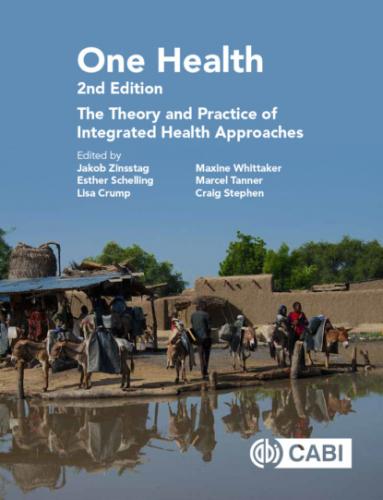Transdisciplinary Research in One Health and Ecohealth
Both quantitative and qualitative approaches enrich our knowledge. True interdisciplinary research programmes in One Health and on zoonoses control are few in number. With some strong exceptions (see Welburn and Coleman, Chapter 21, this volume), so-called ‘socio-economic’ or ‘socio-cultural’ studies on zoonoses are largely questionnaire based, including the knowledge, attitude and practice (KAP) studies, and are often led by veterinarians. These rapid appraisals have several shortcomings, particularly because they do not further describe the context (Allotey et al., 2010). New institutional arrangements between social and biomedical sciences are needed to establish interdisciplinary teams, which can be seen as the motor of transdisciplinary research (Whittaker et al., Chapter 7, this volume). Below we present a few examples of transdisciplinary processes in One Health and ecohealth.
Long-term iterative process in Chad to improve the health of pastoralists and their livestock
Livestock-keeping communities are often excellent observers and know the priority diseases of people and animals in their context. However, in rural and remote rural zones they are confronted with difficulties accessing health services (Danielsen and Schelling, Chapter 14, this volume). To improve health in a credible way in remote rural communities, all health aspects should be reviewed and interventions built on communities’ and authorities’ priorities in a participatory way. Within research partnerships between European and Chadian research institutes, we explored possibilities to improve access to services of mobile pastoralists in Chad, who were previously served by veterinary services but not human health. This aspect was then also one result of an interdisciplinary team including anthropology, social geography, medicine, veterinary epidemiology and microbiology. Other disciplines such as sociology and geography were associated in the further course of the programme with additional funding. Research results also included the absence of a local concept for zoonoses (Krönke, 2004) and that access to key pastoral resources and related conflicts with sedentary communities strongly influenced care-seeking behaviour (Wiese, 2004). Thanks to livestock holders’ reports on perceived poor anthrax vaccine quality, contamination problems in local vaccine production were detected (Schelling et al., 2008). We used the community-based research results to initiate broader collaborations with authorities and scientific experts, and results were reviewed in the communities during focus group discussions and regional workshops to obtain a broader perspective from pastoralist men and women. The research hypothesis and objectives of the complementary studies were guided by the recommendations of the first national workshop in 1998. Indeed, one key recommendation – leading to an advantage of the programme compared with other single-sector studies – was that veterinarians must be associated because livestock, the most important element in the livelihood of mobile pastoralists, could not be excluded.
Repeated stakeholder seminars became crucial elements towards a transdisciplinary process. These allowed the scientists to engage with communities and their representatives and associations, authorities from the Ministry of Health (MoH) and the Ministry of Livestock Production as well as local authorities, technicians and staff, non-governmental organizations (NGOs) working with pastoralists, international bilateral and multilateral organizations such as the World Health Organization (WHO) and the United Nations Children’s Fund (UNICEF) and donors (Léchenne et al., Chapter 19, this volume). The consultative stakeholder seminars aimed to define priorities of the populations and the authorities jointly, formulating health service priorities from a range of options and readjusting ongoing interventions but also cross-checking the relevance of activities. Pastoralists could express their concerns and needs directly to the authorities and also voice non-health-related demands such as requests for new legislation on land use. The priority-setting process started from health-system-driven approaches – pragmatic in the sense that interventions could be carried out by the health and veterinary services and be validated by involved scientists – and moved incrementally towards the inclusion of other community priorities. The participants identified new research and intervention objectives and, consequently, trust and mutual respect were gradually built. The programme became the interlocutor between pastoralists and the authorities, and the communities were empowered to take their own initiatives (Schelling et al., 2008).
In conjunction with the stakeholder workshop in 2005 a process of inter-ministerial planning of a national action plan to support nomadic communities in Chad started under the leadership of the Ministry of Planning in collaboration with eight other ministries (Fig. 6.1A). However, intersectoral negotiations with so many ministries proved to be too ambitious and were not feasible. The new course, where the MoH took the lead, turned out to be more operational. During the workshop in 2013, the MoH announced the creation of a directorate for the health of mobile pastoralists. Activities that are implemented as a result of the transdisciplinary process, particularly the joint human and animal vaccination campaigns – currently in trans-frontier zones – are maintained and led by the government. There is also a presidential decree for full Expanded Programme on Immunization (EPI) coverage for pastoralist children along with polio vaccination days. The ‘Association des jeunes nomades’ is more active and prominent than ever, regarding the problem of pastoralists as an institutional problem. These dynamics of pastoralist representation would hardly have been possible some years earlier when only a few pastoralists had received higher
